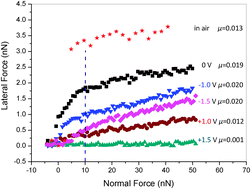An ionic liquid lubricant enables superlubricity to be “switched on” in situ using an electrical potential†
Abstract
Atomic force microscopy measurements reveal that superlubricity can be “switched” on and off in situ when an ionic liquid is used to lubricate the silica–graphite interface. Applying a potential to the graphite surface changes the ion composition of the boundary layer and thus the lubricity. At positive potentials, when the interfacial ion layer is anion rich, friction falls to ultra-low levels.


 Please wait while we load your content...
Please wait while we load your content...